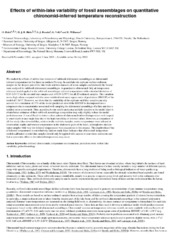| dc.contributor.author | Heiri, Oliver | eng |
| dc.contributor.author | Birks, Harry John Betteley | eng |
| dc.contributor.author | Brooks, Stephen J. | eng |
| dc.contributor.author | Velle, Gaute | eng |
| dc.contributor.author | Willassen, Endre | eng |
| dc.date.accessioned | 2004-07-29T10:01:37Z | |
| dc.date.accessioned | 2004-08-03T12:58:06Z | |
| dc.date.accessioned | 2004-08-26T11:58:15Z | |
| dc.date.available | 2004-07-29T10:01:37Z | |
| dc.date.available | 2004-08-03T12:58:06Z | |
| dc.date.available | 2004-08-26T11:58:15Z | |
| dc.date.issued | 2003 | eng |
| dc.Published | Palaeogeography, Palaeoclimatology, Palaeoecology 2003 199(1-2): 95-106 | en |
| dc.identifier.issn | 0031-0182 | en_US |
| dc.identifier.uri | https://hdl.handle.net/1956/397 | |
| dc.description.abstract | We studied the effects of within-lake variation of subfossil chironomid assemblages on chironomid-inferred temperatures in five lakes in southern Norway. In each lake six replicate surface-sediment samples in the deepest part of the lake basin and two transects of seven samples each towards the littoral were analysed for subfossil chironomid assemblages. A quantitative chironomid–July air temperature inference model applied to the subfossil assemblages inferred temperatures with a standard deviation of 0.35–0.54°C for the six mid-lake samples and of 0.38–0.59°C for all 20 sediment samples. This variation seems high when compared with the cross-validated root mean square error of prediction (RMSEP) of the model of 1.04°C. However, we show that the variability of the replicate mid-lake samples can only account for a maximum of 15% of the model prediction error if the RMSEP is decomposed into a component due to uncertainties associated with sampling the chironomid assemblage of a lake and into a residual error component. Thus, according to our results analysing multiple samples in the model lakes to obtain better estimates of their subfossil assemblage composition may only slightly reduce the model prediction error. It was difficult to detect a clear pattern of chironomid-inferred temperatures with respect to water depth in any single lake due to the high variability of inferred values. However, a comparison of all five study lakes revealed that, relative to the mid-lake samples, cooler temperatures were inferred at intermediate depths and warmer temperatures in the shallowest parts of the lakes, although two shallow-water samples with very low inferred temperatures were exceptions in this respect. This depth-related bias of inferred temperatures in our relatively shallow study lakes indicates that chironomid–temperature models calibrated on mid-lake samples should only be applied with caution to near-shore sediments and that a systematic offset in the inferred temperatures may occur. | en_US |
| dc.format.extent | 39607 bytes | eng |
| dc.format.extent | 282908 bytes | eng |
| dc.format.extent | 166 bytes | eng |
| dc.format.mimetype | text/plain | eng |
| dc.format.mimetype | application/pdf | eng |
| dc.format.mimetype | text/plain | eng |
| dc.language.iso | eng | eng |
| dc.publisher | Elsevier | en_US |
| dc.subject | Subfossil chironomids | eng |
| dc.subject | Temperature reconstruction | eng |
| dc.subject | Prediction error | eng |
| dc.subject | Within-lake variability | eng |
| dc.subject | Palaeolimnology | eng |
| dc.title | Effects of within-lake variability of fossil assemblages on quantitative chironomid-inferred temperature reconstruction | en_US |
| dc.type | Peer reviewed | |
| dc.type | Journal article | |
| dc.rights.holder | Copyright 2003 Elsevier B.V. | en_US |
| dc.identifier.doi | https://doi.org/10.1016/s0031-0182(03)00498-x | |
